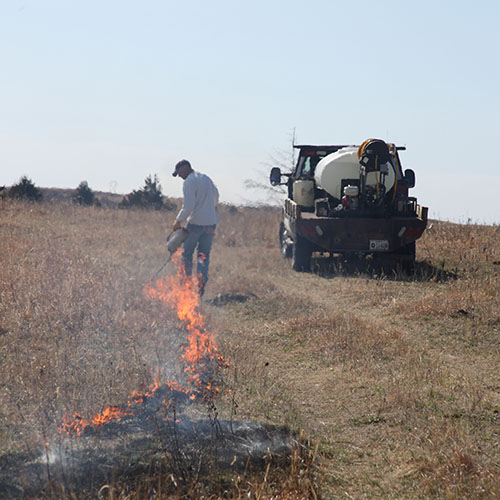March 18, 2025
Prescribed Burn Season is Here!

As the days grow longer and native plants begin to come out of dormancy, it’s time for prescribed burning activity to increase. During a typical spring, over 2 million acres in the Flint Hills region of Kansas and Oklahoma Flint Hills region will burn, as well as additional acres across the state. Prescribed burning activity has also increased over the last decade in neighboring states, so there is potential for plenty of smoke in the air.
Last year much of the Flint Hills had dry to drought conditions and much of the prescribed burning was deferred, waiting for more favorable conditions. Based on February discussions with county Extension agents, there is better moisture this spring in the northern Flint Hills but dry conditions linger in the south.
Prescribed burning accomplishes many things. A recent survey of Prescribed Burn Associations in the Great Plains identified the top objectives for prescribed burns as: management of invasive species or woody encroachment (93%), rangeland or forage enhancement (76%), and wildlife habitat (55%).
Prescribed burners are encouraged to consider their smoke impact both locally (smoke on roads, sensitive populations such as nursing homes and schools) and regionally. Smoke can cause impacts many miles from the source. When more acres are burned at the same time, the chance of regional smoke impacts increases. Burning will be more concentrated when 1) few days have good weather conditions for burning; 2) burn bans reduced the number of days available for burning; and 3) “catch-up” burning occurs, when additional acres are burned that could not be burned last year (such as due to drought conditions).
The smoke management website (ksfire.org) contains a model that allows ag producers to see when smoke is likely to cause an impact on an air quality monitor. Of special concern are weather conditions called inversions, which keep smoke near the ground as it travels, especially at night. Inversions are common in the spring, less common in the summer and early fall. Inversions generally lift by noon, but can cause very smoky conditions in the early morning hours. Since many schools make decisions about outdoor activities early in the day, this can be an annoying problem when events are called off but there is no smoke by the time of the scheduled activity.
Consider moving prescribed burning to later in the year where feasible and appropriate.
The Kansas Department of Health and Environment suggests the following steps to protect your health on days when smoke is present in your community:
• Healthy people should consider limiting or avoiding strenuous outdoor exercise.
• Vulnerable people should remain indoors.
• Keep indoor air clean by closing doors and windows and running air conditioners with air filters.
• Stay hydrated by drinking plenty of water.
• Contact your doctor if you have symptoms such as chest pain, chest tightness, shortness of breath or severe fatigue.
A health alert related to prescribed burning can be found at: https://www.ksfire.org/docs/2025_Flint_Hills_Health_Advisory.pdf